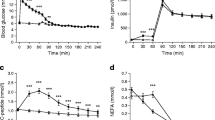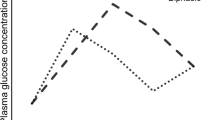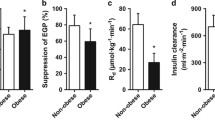Summary
Relationship between body fat distribution, serum insulin, and glucose tolerance in obese, non-diabetic women. Recent studies suggest that hyperinsulinemia and upper body obesity are predictive factors for the development of non-insulindependent diabetes mellitus. To further characterize the relationship between body fat distribution, serum insulin, and glucose tolerance an oral glucose tolerance test was performed in 48 obese, nondiabetic women. Fasting insulin levels were correlated to both total body fat calculated as body mass index (r=0.58,p<0.001) and upper body fat distribution expressed as waist-to-hip ratio (WHR,r=0.47,p<0.01). In the women with upper body fat localization (WHR>0.90) significantly higher basal and glucose-stimulated insulin concentrations were established than in the women with a lower body type of obesity (WHR<0.78) (basal insulin 27.4±11.5 vs. 15.4±8.8 mU/l,p<0.05, insulin area 779±320 vs. 468±237 U,p<0.05). They also had impaired glucose tolerance (glucose area 925±139 vs. 633±147 U,p<0.01). Fasting triglyceride concentrations were correlated both with WHR (r=0.63,p<0.001) and fasting insulin (r=0.33,p<0.05) but not with BMI (r=−0.02, n.s.). A positive association was found between systolic and diastolic blood pressure and both WHR (r=0.43 andr=0.44 resp.,p<0.01) and BMI (eachr=0.35,p<0.05). Interestingly, basal insulin was also associated with blood pressure (r=0.30,p<0.1, andr=0.40,p<0.01 resp.). These results suggest a close relationship between upper body obesity, hyperinsulinemia, and impaired glucose tolerance. Women with an upper body tpye of obesity also show tendencies to hypertriglyceridemia and hypertension. Obese women with upper body obesity represent a subgroup of the obesity population with an increased risk to develop type-II diabetes.
Similar content being viewed by others
Abbreviations
- BMI:
-
Body Mass Index
- WHR:
-
Waist-to-Hip Ratio
- Hb-A1:
-
glykosiliertes Hämoglobin
- LDL:
-
low density lipoproteins
- HDL:
-
high density lipoproteins
- RR:
-
Blutdruck
Literatur
Ashwell M, Cole TJ, Dixon AK (1985) Obesity: New insight into the anthropometric classification of fat distribution shown by computed tomography. Br Med J 290:1692–1694
Beischer W, Keller L, Maas M, Schiefer E, Pfeiffer EF (1976) Human C-peptide. I. Radioimmunoassay. Klin Wochenschr 54:709–717
Björntorp P (1984) Morphological classifications of obesity: What they tell us, what they don't. Int J Obesity 8:525–533
Blair D, Habicht JP, Sims EAH, Sylvester D, Abraham S (1984) Evidence for an increased risk of hypertension with centrally located body fat and the effect of race and sex on this risk. Am J Epidemiol 119:526–540
Bogardus C, Lillioja S, Foley J, Christin L, Freymond D, Nyomba B, Bennett PH, Reaven G, Salans L (1987) Insulin resistance predicts the development of non-insulin dependent diabetes mellitus in Pima indians. Diabetes 36, Suppl 1:47A
Bonora E, Zavaroni I, Bruschi F, Alpi O, Pezzarossa A, Guerra L, Dall'aglio E, Coscelli C, Butturini U (1984) Peripheral hyperinsulinemia of simple obesity: pancreatic hypersecretion or impaired insulin metabolism. J Clin Endocrinol Metab 59:1121–1127
Burghen GA, Givens JR, Kitabchi AE (1980) Correlation of hyperandrogenism with hyperinsulinism in polycystic ovarian disease. J Clin Endocrinol Metab 50:113–116
Depres JP, Allard C, Tremblay A, Talbot J, Bouchard C (1985) Evidence for a regional component of body fatness in the association with serum lipids in men and women. Metabolism 34:967–973
Evans JD, Hoffman RG, Kalkhoff RK, Kissebah AH (1983) Relationship of androgenic activity to body fat topography, fat cell morphology, and metabolic aberrations in premenopausal women. J Clin Endocrinol Metab 57:304–310
Evans DJ, Hoffmann RG, Kalkhoff RK, Kissebah AH (1984) Relationship of body fat topography to insulin sensitivity and metabolic profiles in premenopausal women. Metabolism 33:68–75
Faber OK, Christensen K, Kehlet H, Madsbad S, Binder C (1981) Decreased insulin removal contributes to hyperinsulinemia in obesity. J Clin Endocrinol Metab 53:618–621
Hartz AJ, Rupley DC, Kalkhoff RD, Rimm AA (1983) Relationship of obesity to diabetes: influence of obesity level and body fat distribution. Prev Med 12:351–357
Hauner H (1987) Fettgewebsverteilung und Adipositasrisiko. Dtsch Med Wochenschr 112:731–735
Hauner H, Ditschuneit HH, Pal SB, Moncayo R, Pfeiffer EF (1987) Fat distribution, endocrine and metabolic profile in obese women with and without hirsutism. Metabolism (im Druck)
Kalkhoff RK, Hartz AH, Rupley D, Kissebah AH, Kelber S (1983) Relationship of body fat distribution to blood pressure, carbohydrate tolerance, and plasma lipids in healthy obese women. J Lab Clin Med 102:621–627
Karam JH, Grodsky GM, Forsham PH (1963) Excessive insulin response in obese subjects as measured by immunochemical assay. Diabetes 12:197–204
Kerner W, Navascues I, von Schrenck T, Fussgänger R, Arias P, Pfeiffer EF (1985) Characterization of insulin resistance in type-I diabetes. Klin Wochenschr 63:545–553
Kissebah AH, Vydelingum N, Murray R, Evans DJ, Hartz AJ, Kalkhoff RK, Adams PW (1982) Relation of body fat distribution to metabolic complications of obesity. J Clin Endocrinol Metab 54:254–260
Knowler WC, Bennett PH (1983) Serum insulin concentrations predict changes in oral glucose tolerance. Diabetes 32:46A
Kolterman OG, Insel J, Saekow M, Olefsky JM (1980) Mechanism of insulin resistance in human obesity. Evidence for receptor and postreceptor defects. J Clin Invest 65:1272–1280
Krotkiewski M, Björntorp P, Sjöström L, Smith U (1983) Impact of obesity on metabolism in men and women: importance of regional adipose tissue distribution. J Clin Invest 72:1150–1162
Lapidus L, Bengtsson C, Larsson B, Pennert K, Rybo E, Sjöström L (1984) Distribution of adipose tissue and rise of cardiovascular disease and death. A 12 year follow-up of participants in the population of women in Gothenburg. Brit Med J 289:1257–1260
Larsson B, Svärdsudd K, Welin L, Wilhelmsen L, Björntorp P, Tibblin G (1984) Abdominal adipose tissue distribution, obesity and risk of cardiovascular disease and death: 13 year follow-up of participants in the study of men born in 1913. Br Med J 288:1401–1404
Meistas MT, Margolis S, Kowarski A (1983) Hyperinsulinemia in obesity is due to decreased clearance of insulin. Am J Physiol 245:E155-E159
Modan M, Halkin H, Almog S, Lusky A, Eshkol A, Shefi M, Shitrit A, Fuchs Z (1985) Hyperinsulinemia. A link between hypertension, obesity, and glucose tolerance. J Clin Invest 75:809–817
Ohlson LO, Larsson B, Svärdsudd K, Welin L, Eriksson H, Wilhelmsen L, Björntorp P, Tibblin G (1985) The influence of body fat distribution on the incidence of diabetes mellitus. 13.5 years of follow-up of the participants in the study of men born in 1913. Diabetes 34:1055–1058
Olefsky JM (1981) Insulin resistance and insulin action: an in vivo and in vitro perspective. Diabetes 30:148–162
Peiris AN, Mueller RA, Smith GA, Struve MF, Kissebah AH (1986) Splanchnic insulin metabolism in obesity. Influence of body fat distribution. J Clin Invest 78:1648–1657
Peiris AN, Mueller RA, Struve MF, Smith GA, Kissebah AH (1987) Relationship of androgenic activity to splanchnic insulin metabolism and peripheral glucose utilization in premenopausal women. J Clin Endocrinol Metab 64:162–169
Pfeiffer EF (1974) Obesity, islet function and diabetes mellitus. Horm Metabol Res Suppl 4:143–152
Pfeiffer EF (1987) Moderne Vorstellungen über Ätiologie und Pathogenese des Typ-II Diabetes. Internist 28:218–227
Reaven GM, Silvers A, Farquhar JW (1970) Study of the relationship between plasma insulin concentration and efficiency of glucose uptake in normal and mildly diabetic subjects. Diabetes 19:571–578
Reaven GM, Bernstein R, Davis B, Olefsky JM (1976) Nonketotic diabetes mellitus: insulin deficiency or insulin resistance. Am J Med 60:80–88
Sims EAH, Horton ES (1968) Endocrine and metabolic adaption to obesity and starvation. Am J Clin Nutr 21:1455–1470
Steiner G, Vranic M (1982) Hyperinsulinemia and hypertriglyceridemia, a vicious cycle with atherogenic potential. Int J Obesity 6, Suppl 1:117–124
Stern MP, Haffner SM (1986) Body fat distribution and hyperinsulinemia as risk factors for diabetes and cardiovascular disease. Arteriosclerosis 6:123–130
Swislocki ALM, Donner CC, Fraze E, Chen YDI, Reaven GM (1987) Can insulin resistance exist as a primary defect in non-insulin dependent diabetes mellitus. J Clin Endocrinol Metab 64:778–782
Unger RH, Grundy S (1985) Hyperglycemia as an inducer as well as a consequence of impaired islet cell function and insulin resistance: implications for the management of diabetes. Diabetologia 28:119–121
Vague J (1956) The degree of masculine differentiation of obesities. A factor determining predisposition to diabetes, atherosclerosis, gout, and uric calculous disease. Am J Clin Nutr 4:20–34
Ward WK, Beard JC, Halter JB, Pfeifer MA, Porte D (1984) Pathophysiology of insulin secretion in non-insulin dependent diabetes mellitus. Diabetes Care 7:491–502
Author information
Authors and Affiliations
Additional information
Teile dieser Untersuchung wurden auf der 22. Jahrestagung der Deutschen Diabetes-Gesellschaft in Aachen (28.–30. Mai 1987) vorgetragen.
Rights and permissions
About this article
Cite this article
Hauner, H., Pfeiffer, E.F. Die Beziehung zwischen Körperfettverteilung, Insulinspiegeln und Glukosetoleranz bei übergewichtigen Frauen. Klin Wochenschr 66, 216–222 (1988). https://doi.org/10.1007/BF01728200
Received:
Revised:
Accepted:
Issue Date:
DOI: https://doi.org/10.1007/BF01728200




